Analyzing Big Data Applications: Healthcare and Semiconductor Sectors
VerifiedAdded on 2021/04/17
|10
|3085
|62
Project
AI Summary
This project delves into the transformative impact of big data analytics across two key sectors: healthcare and semiconductor manufacturing. The first case study examines how big data enhances efficiency and effectiveness within healthcare, focusing on electronic patient records, real-time data analysis, and improved decision-making through the implementation of big data analytics. The second case study explores the semiconductor industry, highlighting how big data optimizes manufacturing processes, from fault detection and predictive maintenance to supply chain management and virtual environment simulations. The project emphasizes the adoption of big data analytics for streamlining operations, improving data quality, and enhancing overall performance. The analysis includes the application of the 5V model of big data (Volume, Velocity, Variety, Value, and Veracity) and the implementation of various techniques for handling and analyzing large datasets, ultimately leading to improved outcomes and innovation in both sectors. The project also touches upon the challenges faced during the adoption of big data analytics, such as complexity and data quality issues, along with potential solutions for overcoming them. The study emphasizes the importance of adapting to the changing technological landscape to improve efficiency and decision-making capabilities.

Project Management
Paraphrase This Document
Need a fresh take? Get an instant paraphrase of this document with our AI Paraphraser

Contents
Introduction...........................................................................................................................................2
Description:...........................................................................................................................................2
Conclusion.............................................................................................................................................7
Reference:.............................................................................................................................................8
Introduction...........................................................................................................................................2
Description:...........................................................................................................................................2
Conclusion.............................................................................................................................................7
Reference:.............................................................................................................................................8
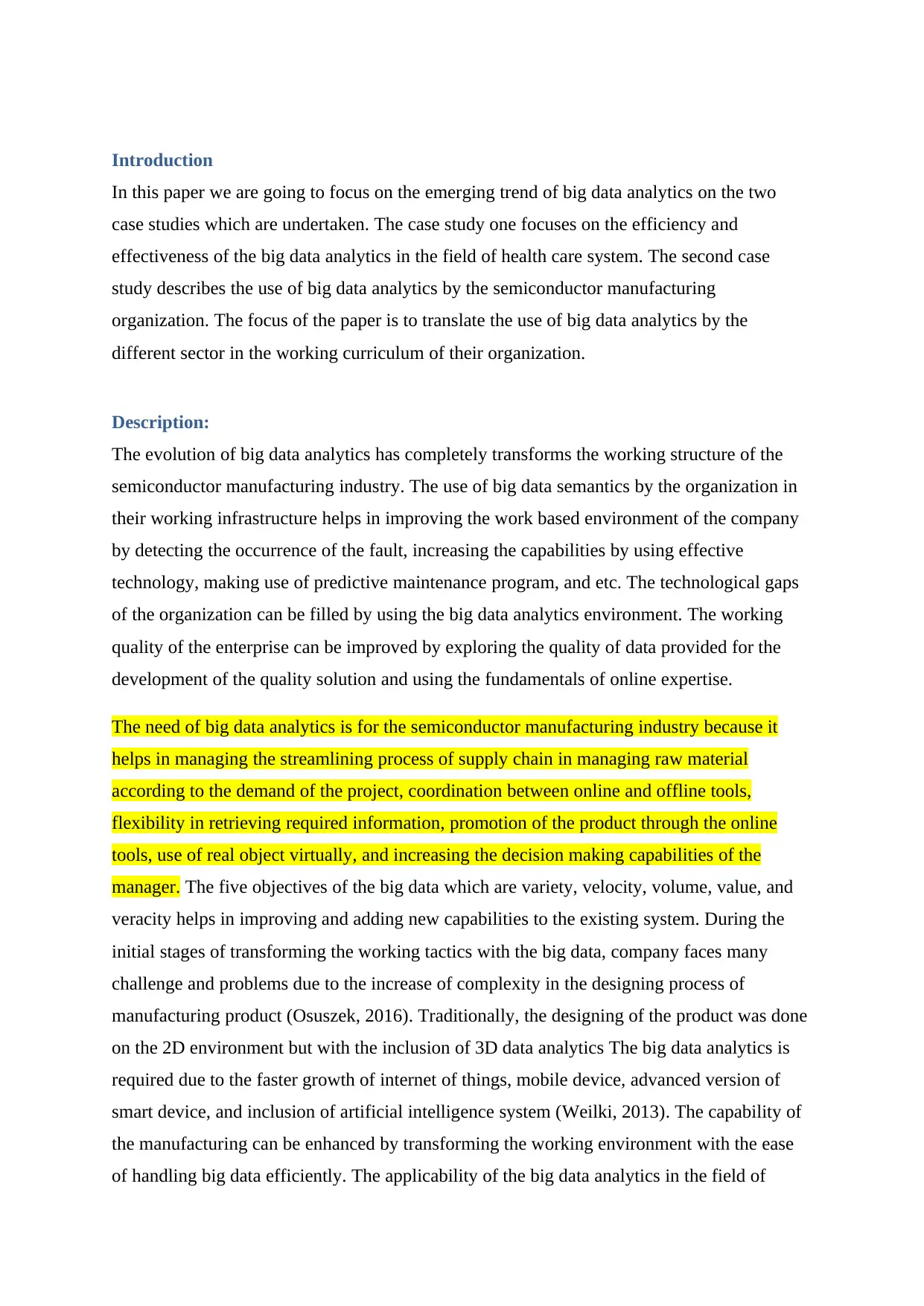
Introduction
In this paper we are going to focus on the emerging trend of big data analytics on the two
case studies which are undertaken. The case study one focuses on the efficiency and
effectiveness of the big data analytics in the field of health care system. The second case
study describes the use of big data analytics by the semiconductor manufacturing
organization. The focus of the paper is to translate the use of big data analytics by the
different sector in the working curriculum of their organization.
Description:
The evolution of big data analytics has completely transforms the working structure of the
semiconductor manufacturing industry. The use of big data semantics by the organization in
their working infrastructure helps in improving the work based environment of the company
by detecting the occurrence of the fault, increasing the capabilities by using effective
technology, making use of predictive maintenance program, and etc. The technological gaps
of the organization can be filled by using the big data analytics environment. The working
quality of the enterprise can be improved by exploring the quality of data provided for the
development of the quality solution and using the fundamentals of online expertise.
The need of big data analytics is for the semiconductor manufacturing industry because it
helps in managing the streamlining process of supply chain in managing raw material
according to the demand of the project, coordination between online and offline tools,
flexibility in retrieving required information, promotion of the product through the online
tools, use of real object virtually, and increasing the decision making capabilities of the
manager. The five objectives of the big data which are variety, velocity, volume, value, and
veracity helps in improving and adding new capabilities to the existing system. During the
initial stages of transforming the working tactics with the big data, company faces many
challenge and problems due to the increase of complexity in the designing process of
manufacturing product (Osuszek, 2016). Traditionally, the designing of the product was done
on the 2D environment but with the inclusion of 3D data analytics The big data analytics is
required due to the faster growth of internet of things, mobile device, advanced version of
smart device, and inclusion of artificial intelligence system (Weilki, 2013). The capability of
the manufacturing can be enhanced by transforming the working environment with the ease
of handling big data efficiently. The applicability of the big data analytics in the field of
In this paper we are going to focus on the emerging trend of big data analytics on the two
case studies which are undertaken. The case study one focuses on the efficiency and
effectiveness of the big data analytics in the field of health care system. The second case
study describes the use of big data analytics by the semiconductor manufacturing
organization. The focus of the paper is to translate the use of big data analytics by the
different sector in the working curriculum of their organization.
Description:
The evolution of big data analytics has completely transforms the working structure of the
semiconductor manufacturing industry. The use of big data semantics by the organization in
their working infrastructure helps in improving the work based environment of the company
by detecting the occurrence of the fault, increasing the capabilities by using effective
technology, making use of predictive maintenance program, and etc. The technological gaps
of the organization can be filled by using the big data analytics environment. The working
quality of the enterprise can be improved by exploring the quality of data provided for the
development of the quality solution and using the fundamentals of online expertise.
The need of big data analytics is for the semiconductor manufacturing industry because it
helps in managing the streamlining process of supply chain in managing raw material
according to the demand of the project, coordination between online and offline tools,
flexibility in retrieving required information, promotion of the product through the online
tools, use of real object virtually, and increasing the decision making capabilities of the
manager. The five objectives of the big data which are variety, velocity, volume, value, and
veracity helps in improving and adding new capabilities to the existing system. During the
initial stages of transforming the working tactics with the big data, company faces many
challenge and problems due to the increase of complexity in the designing process of
manufacturing product (Osuszek, 2016). Traditionally, the designing of the product was done
on the 2D environment but with the inclusion of 3D data analytics The big data analytics is
required due to the faster growth of internet of things, mobile device, advanced version of
smart device, and inclusion of artificial intelligence system (Weilki, 2013). The capability of
the manufacturing can be enhanced by transforming the working environment with the ease
of handling big data efficiently. The applicability of the big data analytics in the field of
⊘ This is a preview!⊘
Do you want full access?
Subscribe today to unlock all pages.

Trusted by 1+ million students worldwide
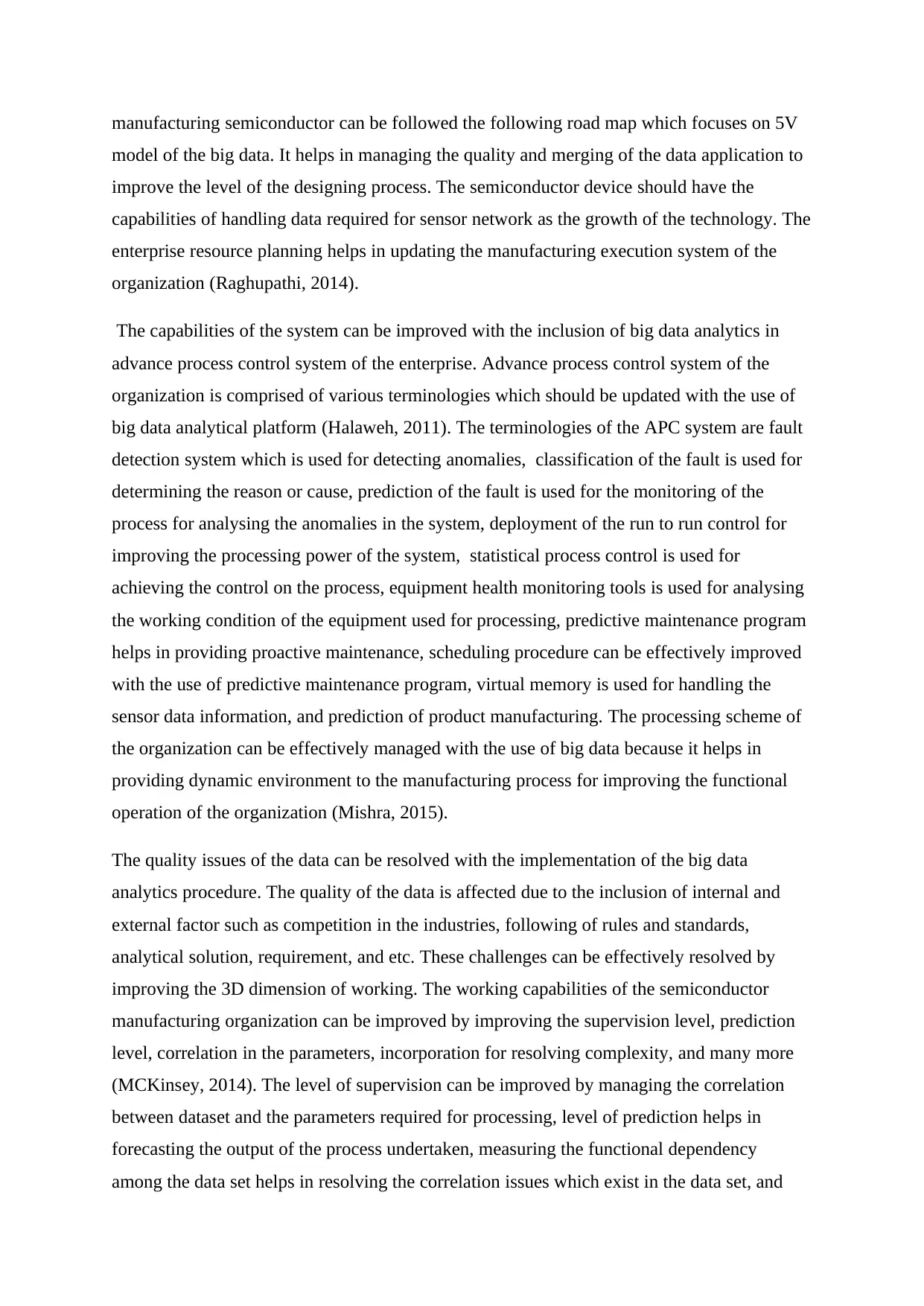
manufacturing semiconductor can be followed the following road map which focuses on 5V
model of the big data. It helps in managing the quality and merging of the data application to
improve the level of the designing process. The semiconductor device should have the
capabilities of handling data required for sensor network as the growth of the technology. The
enterprise resource planning helps in updating the manufacturing execution system of the
organization (Raghupathi, 2014).
The capabilities of the system can be improved with the inclusion of big data analytics in
advance process control system of the enterprise. Advance process control system of the
organization is comprised of various terminologies which should be updated with the use of
big data analytical platform (Halaweh, 2011). The terminologies of the APC system are fault
detection system which is used for detecting anomalies, classification of the fault is used for
determining the reason or cause, prediction of the fault is used for the monitoring of the
process for analysing the anomalies in the system, deployment of the run to run control for
improving the processing power of the system, statistical process control is used for
achieving the control on the process, equipment health monitoring tools is used for analysing
the working condition of the equipment used for processing, predictive maintenance program
helps in providing proactive maintenance, scheduling procedure can be effectively improved
with the use of predictive maintenance program, virtual memory is used for handling the
sensor data information, and prediction of product manufacturing. The processing scheme of
the organization can be effectively managed with the use of big data because it helps in
providing dynamic environment to the manufacturing process for improving the functional
operation of the organization (Mishra, 2015).
The quality issues of the data can be resolved with the implementation of the big data
analytics procedure. The quality of the data is affected due to the inclusion of internal and
external factor such as competition in the industries, following of rules and standards,
analytical solution, requirement, and etc. These challenges can be effectively resolved by
improving the 3D dimension of working. The working capabilities of the semiconductor
manufacturing organization can be improved by improving the supervision level, prediction
level, correlation in the parameters, incorporation for resolving complexity, and many more
(MCKinsey, 2014). The level of supervision can be improved by managing the correlation
between dataset and the parameters required for processing, level of prediction helps in
forecasting the output of the process undertaken, measuring the functional dependency
among the data set helps in resolving the correlation issues which exist in the data set, and
model of the big data. It helps in managing the quality and merging of the data application to
improve the level of the designing process. The semiconductor device should have the
capabilities of handling data required for sensor network as the growth of the technology. The
enterprise resource planning helps in updating the manufacturing execution system of the
organization (Raghupathi, 2014).
The capabilities of the system can be improved with the inclusion of big data analytics in
advance process control system of the enterprise. Advance process control system of the
organization is comprised of various terminologies which should be updated with the use of
big data analytical platform (Halaweh, 2011). The terminologies of the APC system are fault
detection system which is used for detecting anomalies, classification of the fault is used for
determining the reason or cause, prediction of the fault is used for the monitoring of the
process for analysing the anomalies in the system, deployment of the run to run control for
improving the processing power of the system, statistical process control is used for
achieving the control on the process, equipment health monitoring tools is used for analysing
the working condition of the equipment used for processing, predictive maintenance program
helps in providing proactive maintenance, scheduling procedure can be effectively improved
with the use of predictive maintenance program, virtual memory is used for handling the
sensor data information, and prediction of product manufacturing. The processing scheme of
the organization can be effectively managed with the use of big data because it helps in
providing dynamic environment to the manufacturing process for improving the functional
operation of the organization (Mishra, 2015).
The quality issues of the data can be resolved with the implementation of the big data
analytics procedure. The quality of the data is affected due to the inclusion of internal and
external factor such as competition in the industries, following of rules and standards,
analytical solution, requirement, and etc. These challenges can be effectively resolved by
improving the 3D dimension of working. The working capabilities of the semiconductor
manufacturing organization can be improved by improving the supervision level, prediction
level, correlation in the parameters, incorporation for resolving complexity, and many more
(MCKinsey, 2014). The level of supervision can be improved by managing the correlation
between dataset and the parameters required for processing, level of prediction helps in
forecasting the output of the process undertaken, measuring the functional dependency
among the data set helps in resolving the correlation issues which exist in the data set, and
Paraphrase This Document
Need a fresh take? Get an instant paraphrase of this document with our AI Paraphraser
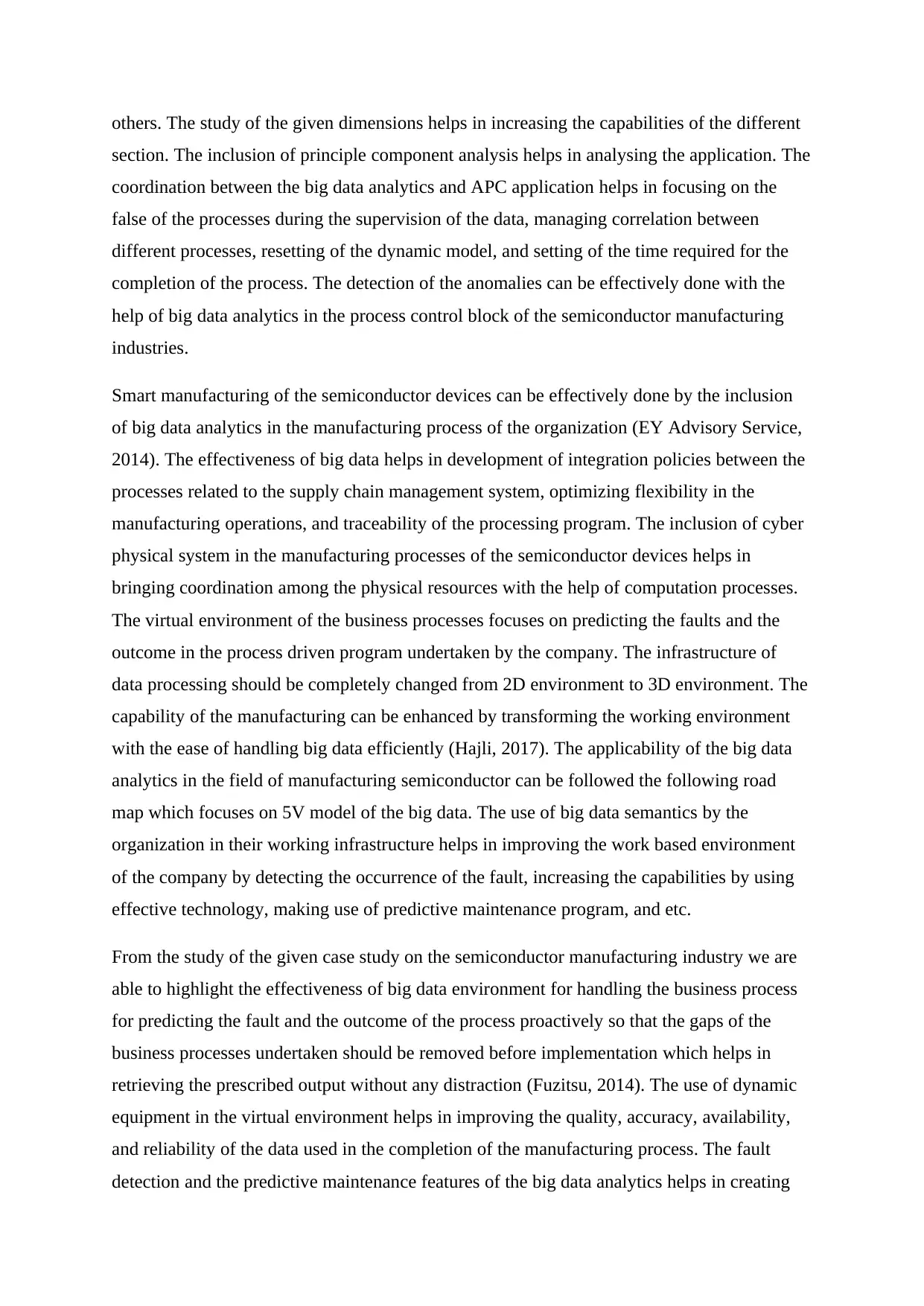
others. The study of the given dimensions helps in increasing the capabilities of the different
section. The inclusion of principle component analysis helps in analysing the application. The
coordination between the big data analytics and APC application helps in focusing on the
false of the processes during the supervision of the data, managing correlation between
different processes, resetting of the dynamic model, and setting of the time required for the
completion of the process. The detection of the anomalies can be effectively done with the
help of big data analytics in the process control block of the semiconductor manufacturing
industries.
Smart manufacturing of the semiconductor devices can be effectively done by the inclusion
of big data analytics in the manufacturing process of the organization (EY Advisory Service,
2014). The effectiveness of big data helps in development of integration policies between the
processes related to the supply chain management system, optimizing flexibility in the
manufacturing operations, and traceability of the processing program. The inclusion of cyber
physical system in the manufacturing processes of the semiconductor devices helps in
bringing coordination among the physical resources with the help of computation processes.
The virtual environment of the business processes focuses on predicting the faults and the
outcome in the process driven program undertaken by the company. The infrastructure of
data processing should be completely changed from 2D environment to 3D environment. The
capability of the manufacturing can be enhanced by transforming the working environment
with the ease of handling big data efficiently (Hajli, 2017). The applicability of the big data
analytics in the field of manufacturing semiconductor can be followed the following road
map which focuses on 5V model of the big data. The use of big data semantics by the
organization in their working infrastructure helps in improving the work based environment
of the company by detecting the occurrence of the fault, increasing the capabilities by using
effective technology, making use of predictive maintenance program, and etc.
From the study of the given case study on the semiconductor manufacturing industry we are
able to highlight the effectiveness of big data environment for handling the business process
for predicting the fault and the outcome of the process proactively so that the gaps of the
business processes undertaken should be removed before implementation which helps in
retrieving the prescribed output without any distraction (Fuzitsu, 2014). The use of dynamic
equipment in the virtual environment helps in improving the quality, accuracy, availability,
and reliability of the data used in the completion of the manufacturing process. The fault
detection and the predictive maintenance features of the big data analytics helps in creating
section. The inclusion of principle component analysis helps in analysing the application. The
coordination between the big data analytics and APC application helps in focusing on the
false of the processes during the supervision of the data, managing correlation between
different processes, resetting of the dynamic model, and setting of the time required for the
completion of the process. The detection of the anomalies can be effectively done with the
help of big data analytics in the process control block of the semiconductor manufacturing
industries.
Smart manufacturing of the semiconductor devices can be effectively done by the inclusion
of big data analytics in the manufacturing process of the organization (EY Advisory Service,
2014). The effectiveness of big data helps in development of integration policies between the
processes related to the supply chain management system, optimizing flexibility in the
manufacturing operations, and traceability of the processing program. The inclusion of cyber
physical system in the manufacturing processes of the semiconductor devices helps in
bringing coordination among the physical resources with the help of computation processes.
The virtual environment of the business processes focuses on predicting the faults and the
outcome in the process driven program undertaken by the company. The infrastructure of
data processing should be completely changed from 2D environment to 3D environment. The
capability of the manufacturing can be enhanced by transforming the working environment
with the ease of handling big data efficiently (Hajli, 2017). The applicability of the big data
analytics in the field of manufacturing semiconductor can be followed the following road
map which focuses on 5V model of the big data. The use of big data semantics by the
organization in their working infrastructure helps in improving the work based environment
of the company by detecting the occurrence of the fault, increasing the capabilities by using
effective technology, making use of predictive maintenance program, and etc.
From the study of the given case study on the semiconductor manufacturing industry we are
able to highlight the effectiveness of big data environment for handling the business process
for predicting the fault and the outcome of the process proactively so that the gaps of the
business processes undertaken should be removed before implementation which helps in
retrieving the prescribed output without any distraction (Fuzitsu, 2014). The use of dynamic
equipment in the virtual environment helps in improving the quality, accuracy, availability,
and reliability of the data used in the completion of the manufacturing process. The fault
detection and the predictive maintenance features of the big data analytics helps in creating
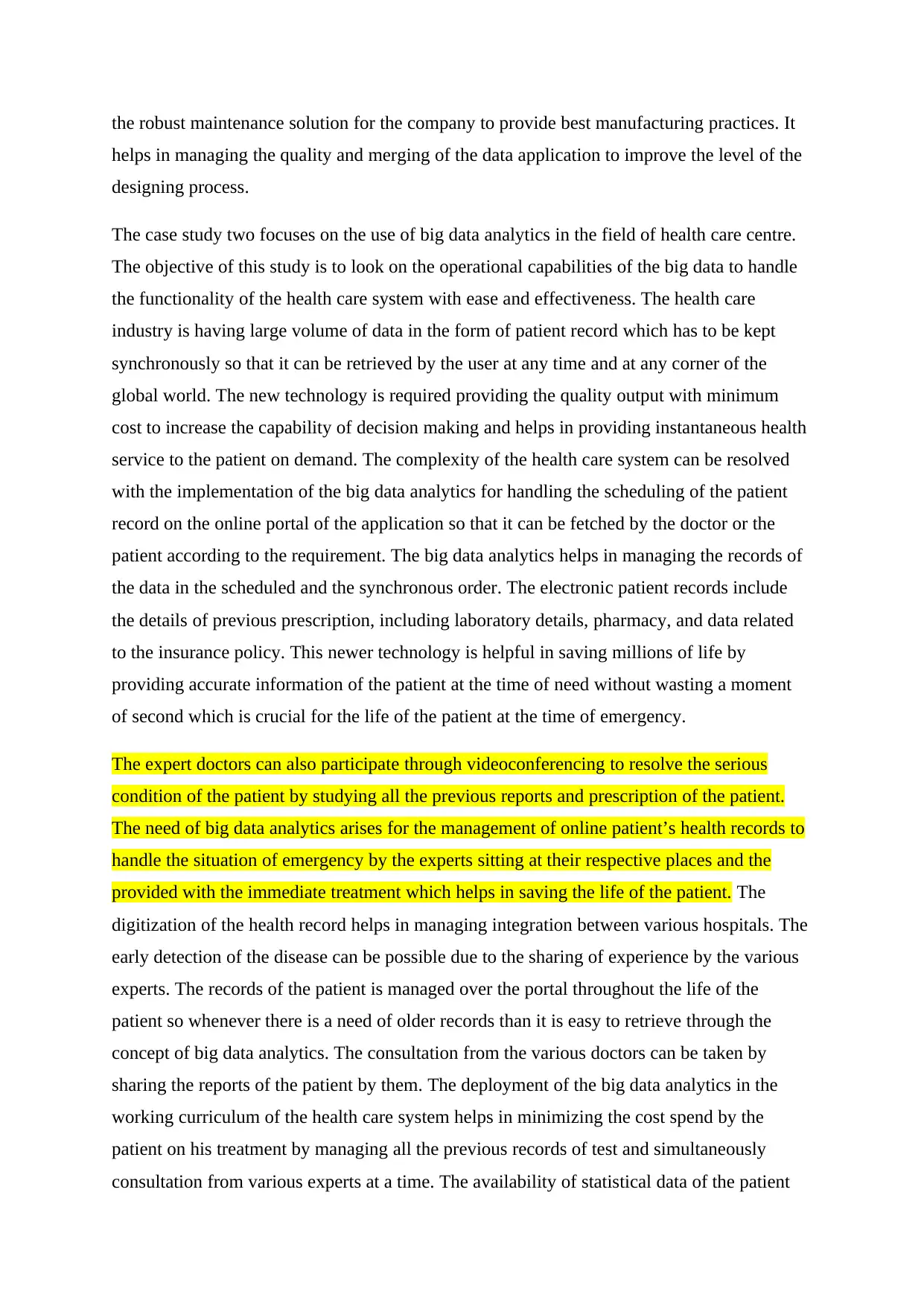
the robust maintenance solution for the company to provide best manufacturing practices. It
helps in managing the quality and merging of the data application to improve the level of the
designing process.
The case study two focuses on the use of big data analytics in the field of health care centre.
The objective of this study is to look on the operational capabilities of the big data to handle
the functionality of the health care system with ease and effectiveness. The health care
industry is having large volume of data in the form of patient record which has to be kept
synchronously so that it can be retrieved by the user at any time and at any corner of the
global world. The new technology is required providing the quality output with minimum
cost to increase the capability of decision making and helps in providing instantaneous health
service to the patient on demand. The complexity of the health care system can be resolved
with the implementation of the big data analytics for handling the scheduling of the patient
record on the online portal of the application so that it can be fetched by the doctor or the
patient according to the requirement. The big data analytics helps in managing the records of
the data in the scheduled and the synchronous order. The electronic patient records include
the details of previous prescription, including laboratory details, pharmacy, and data related
to the insurance policy. This newer technology is helpful in saving millions of life by
providing accurate information of the patient at the time of need without wasting a moment
of second which is crucial for the life of the patient at the time of emergency.
The expert doctors can also participate through videoconferencing to resolve the serious
condition of the patient by studying all the previous reports and prescription of the patient.
The need of big data analytics arises for the management of online patient’s health records to
handle the situation of emergency by the experts sitting at their respective places and the
provided with the immediate treatment which helps in saving the life of the patient. The
digitization of the health record helps in managing integration between various hospitals. The
early detection of the disease can be possible due to the sharing of experience by the various
experts. The records of the patient is managed over the portal throughout the life of the
patient so whenever there is a need of older records than it is easy to retrieve through the
concept of big data analytics. The consultation from the various doctors can be taken by
sharing the reports of the patient by them. The deployment of the big data analytics in the
working curriculum of the health care system helps in minimizing the cost spend by the
patient on his treatment by managing all the previous records of test and simultaneously
consultation from various experts at a time. The availability of statistical data of the patient
helps in managing the quality and merging of the data application to improve the level of the
designing process.
The case study two focuses on the use of big data analytics in the field of health care centre.
The objective of this study is to look on the operational capabilities of the big data to handle
the functionality of the health care system with ease and effectiveness. The health care
industry is having large volume of data in the form of patient record which has to be kept
synchronously so that it can be retrieved by the user at any time and at any corner of the
global world. The new technology is required providing the quality output with minimum
cost to increase the capability of decision making and helps in providing instantaneous health
service to the patient on demand. The complexity of the health care system can be resolved
with the implementation of the big data analytics for handling the scheduling of the patient
record on the online portal of the application so that it can be fetched by the doctor or the
patient according to the requirement. The big data analytics helps in managing the records of
the data in the scheduled and the synchronous order. The electronic patient records include
the details of previous prescription, including laboratory details, pharmacy, and data related
to the insurance policy. This newer technology is helpful in saving millions of life by
providing accurate information of the patient at the time of need without wasting a moment
of second which is crucial for the life of the patient at the time of emergency.
The expert doctors can also participate through videoconferencing to resolve the serious
condition of the patient by studying all the previous reports and prescription of the patient.
The need of big data analytics arises for the management of online patient’s health records to
handle the situation of emergency by the experts sitting at their respective places and the
provided with the immediate treatment which helps in saving the life of the patient. The
digitization of the health record helps in managing integration between various hospitals. The
early detection of the disease can be possible due to the sharing of experience by the various
experts. The records of the patient is managed over the portal throughout the life of the
patient so whenever there is a need of older records than it is easy to retrieve through the
concept of big data analytics. The consultation from the various doctors can be taken by
sharing the reports of the patient by them. The deployment of the big data analytics in the
working curriculum of the health care system helps in minimizing the cost spend by the
patient on his treatment by managing all the previous records of test and simultaneously
consultation from various experts at a time. The availability of statistical data of the patient
⊘ This is a preview!⊘
Do you want full access?
Subscribe today to unlock all pages.

Trusted by 1+ million students worldwide
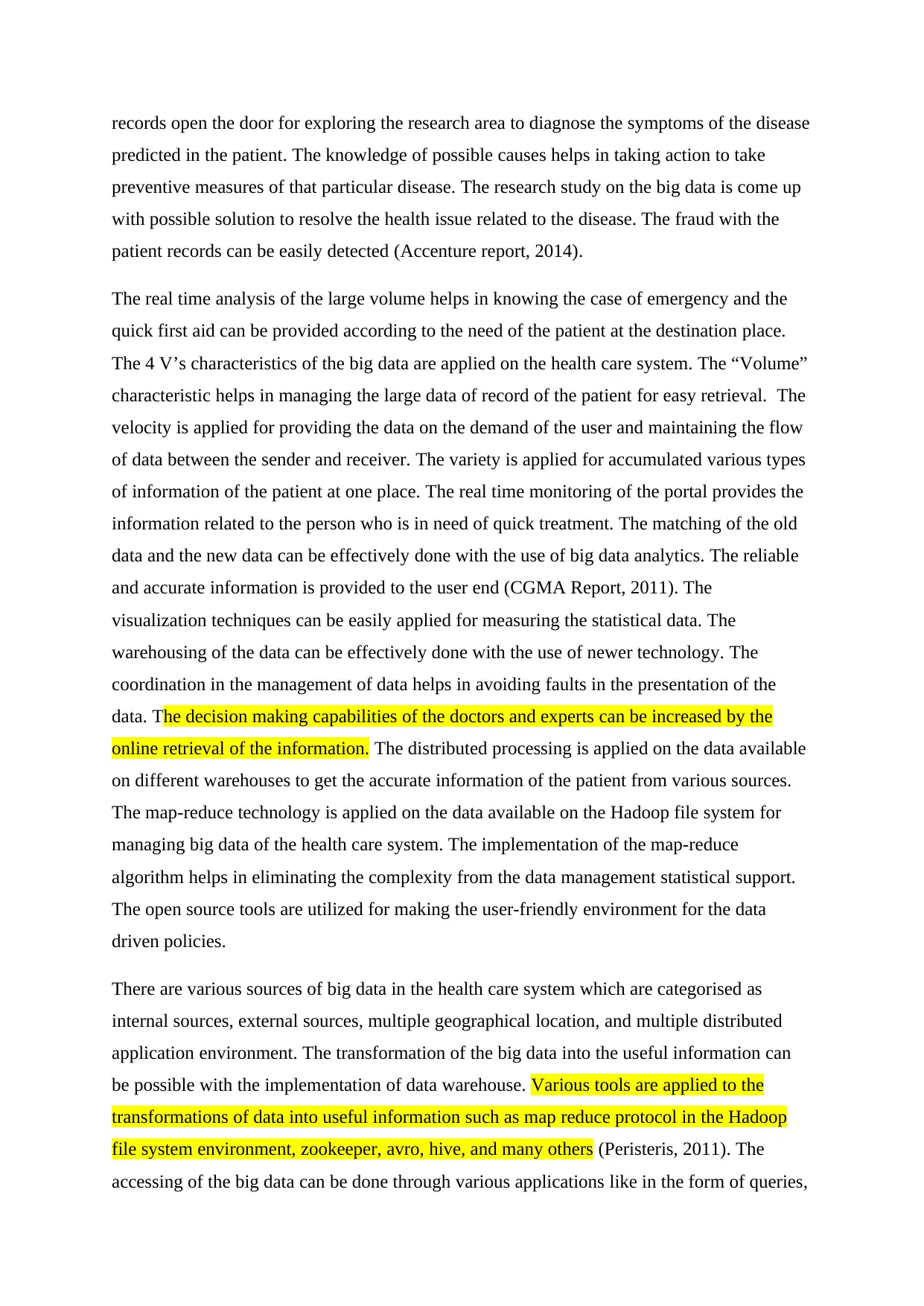
records open the door for exploring the research area to diagnose the symptoms of the disease
predicted in the patient. The knowledge of possible causes helps in taking action to take
preventive measures of that particular disease. The research study on the big data is come up
with possible solution to resolve the health issue related to the disease. The fraud with the
patient records can be easily detected (Accenture report, 2014).
The real time analysis of the large volume helps in knowing the case of emergency and the
quick first aid can be provided according to the need of the patient at the destination place.
The 4 V’s characteristics of the big data are applied on the health care system. The “Volume”
characteristic helps in managing the large data of record of the patient for easy retrieval. The
velocity is applied for providing the data on the demand of the user and maintaining the flow
of data between the sender and receiver. The variety is applied for accumulated various types
of information of the patient at one place. The real time monitoring of the portal provides the
information related to the person who is in need of quick treatment. The matching of the old
data and the new data can be effectively done with the use of big data analytics. The reliable
and accurate information is provided to the user end (CGMA Report, 2011). The
visualization techniques can be easily applied for measuring the statistical data. The
warehousing of the data can be effectively done with the use of newer technology. The
coordination in the management of data helps in avoiding faults in the presentation of the
data. The decision making capabilities of the doctors and experts can be increased by the
online retrieval of the information. The distributed processing is applied on the data available
on different warehouses to get the accurate information of the patient from various sources.
The map-reduce technology is applied on the data available on the Hadoop file system for
managing big data of the health care system. The implementation of the map-reduce
algorithm helps in eliminating the complexity from the data management statistical support.
The open source tools are utilized for making the user-friendly environment for the data
driven policies.
There are various sources of big data in the health care system which are categorised as
internal sources, external sources, multiple geographical location, and multiple distributed
application environment. The transformation of the big data into the useful information can
be possible with the implementation of data warehouse. Various tools are applied to the
transformations of data into useful information such as map reduce protocol in the Hadoop
file system environment, zookeeper, avro, hive, and many others (Peristeris, 2011). The
accessing of the big data can be done through various applications like in the form of queries,
predicted in the patient. The knowledge of possible causes helps in taking action to take
preventive measures of that particular disease. The research study on the big data is come up
with possible solution to resolve the health issue related to the disease. The fraud with the
patient records can be easily detected (Accenture report, 2014).
The real time analysis of the large volume helps in knowing the case of emergency and the
quick first aid can be provided according to the need of the patient at the destination place.
The 4 V’s characteristics of the big data are applied on the health care system. The “Volume”
characteristic helps in managing the large data of record of the patient for easy retrieval. The
velocity is applied for providing the data on the demand of the user and maintaining the flow
of data between the sender and receiver. The variety is applied for accumulated various types
of information of the patient at one place. The real time monitoring of the portal provides the
information related to the person who is in need of quick treatment. The matching of the old
data and the new data can be effectively done with the use of big data analytics. The reliable
and accurate information is provided to the user end (CGMA Report, 2011). The
visualization techniques can be easily applied for measuring the statistical data. The
warehousing of the data can be effectively done with the use of newer technology. The
coordination in the management of data helps in avoiding faults in the presentation of the
data. The decision making capabilities of the doctors and experts can be increased by the
online retrieval of the information. The distributed processing is applied on the data available
on different warehouses to get the accurate information of the patient from various sources.
The map-reduce technology is applied on the data available on the Hadoop file system for
managing big data of the health care system. The implementation of the map-reduce
algorithm helps in eliminating the complexity from the data management statistical support.
The open source tools are utilized for making the user-friendly environment for the data
driven policies.
There are various sources of big data in the health care system which are categorised as
internal sources, external sources, multiple geographical location, and multiple distributed
application environment. The transformation of the big data into the useful information can
be possible with the implementation of data warehouse. Various tools are applied to the
transformations of data into useful information such as map reduce protocol in the Hadoop
file system environment, zookeeper, avro, hive, and many others (Peristeris, 2011). The
accessing of the big data can be done through various applications like in the form of queries,
Paraphrase This Document
Need a fresh take? Get an instant paraphrase of this document with our AI Paraphraser
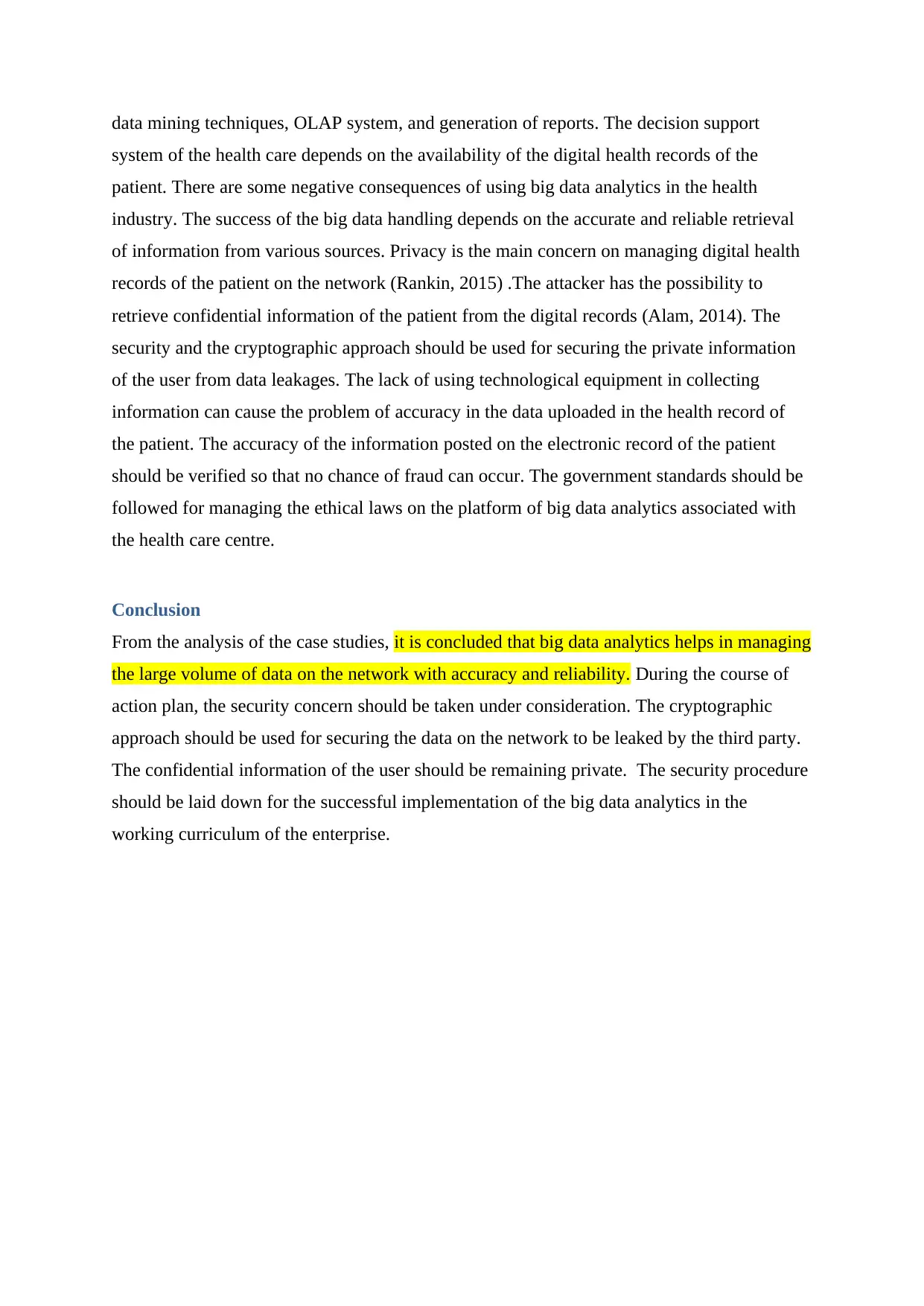
data mining techniques, OLAP system, and generation of reports. The decision support
system of the health care depends on the availability of the digital health records of the
patient. There are some negative consequences of using big data analytics in the health
industry. The success of the big data handling depends on the accurate and reliable retrieval
of information from various sources. Privacy is the main concern on managing digital health
records of the patient on the network (Rankin, 2015) .The attacker has the possibility to
retrieve confidential information of the patient from the digital records (Alam, 2014). The
security and the cryptographic approach should be used for securing the private information
of the user from data leakages. The lack of using technological equipment in collecting
information can cause the problem of accuracy in the data uploaded in the health record of
the patient. The accuracy of the information posted on the electronic record of the patient
should be verified so that no chance of fraud can occur. The government standards should be
followed for managing the ethical laws on the platform of big data analytics associated with
the health care centre.
Conclusion
From the analysis of the case studies, it is concluded that big data analytics helps in managing
the large volume of data on the network with accuracy and reliability. During the course of
action plan, the security concern should be taken under consideration. The cryptographic
approach should be used for securing the data on the network to be leaked by the third party.
The confidential information of the user should be remaining private. The security procedure
should be laid down for the successful implementation of the big data analytics in the
working curriculum of the enterprise.
system of the health care depends on the availability of the digital health records of the
patient. There are some negative consequences of using big data analytics in the health
industry. The success of the big data handling depends on the accurate and reliable retrieval
of information from various sources. Privacy is the main concern on managing digital health
records of the patient on the network (Rankin, 2015) .The attacker has the possibility to
retrieve confidential information of the patient from the digital records (Alam, 2014). The
security and the cryptographic approach should be used for securing the private information
of the user from data leakages. The lack of using technological equipment in collecting
information can cause the problem of accuracy in the data uploaded in the health record of
the patient. The accuracy of the information posted on the electronic record of the patient
should be verified so that no chance of fraud can occur. The government standards should be
followed for managing the ethical laws on the platform of big data analytics associated with
the health care centre.
Conclusion
From the analysis of the case studies, it is concluded that big data analytics helps in managing
the large volume of data on the network with accuracy and reliability. During the course of
action plan, the security concern should be taken under consideration. The cryptographic
approach should be used for securing the data on the network to be leaked by the third party.
The confidential information of the user should be remaining private. The security procedure
should be laid down for the successful implementation of the big data analytics in the
working curriculum of the enterprise.
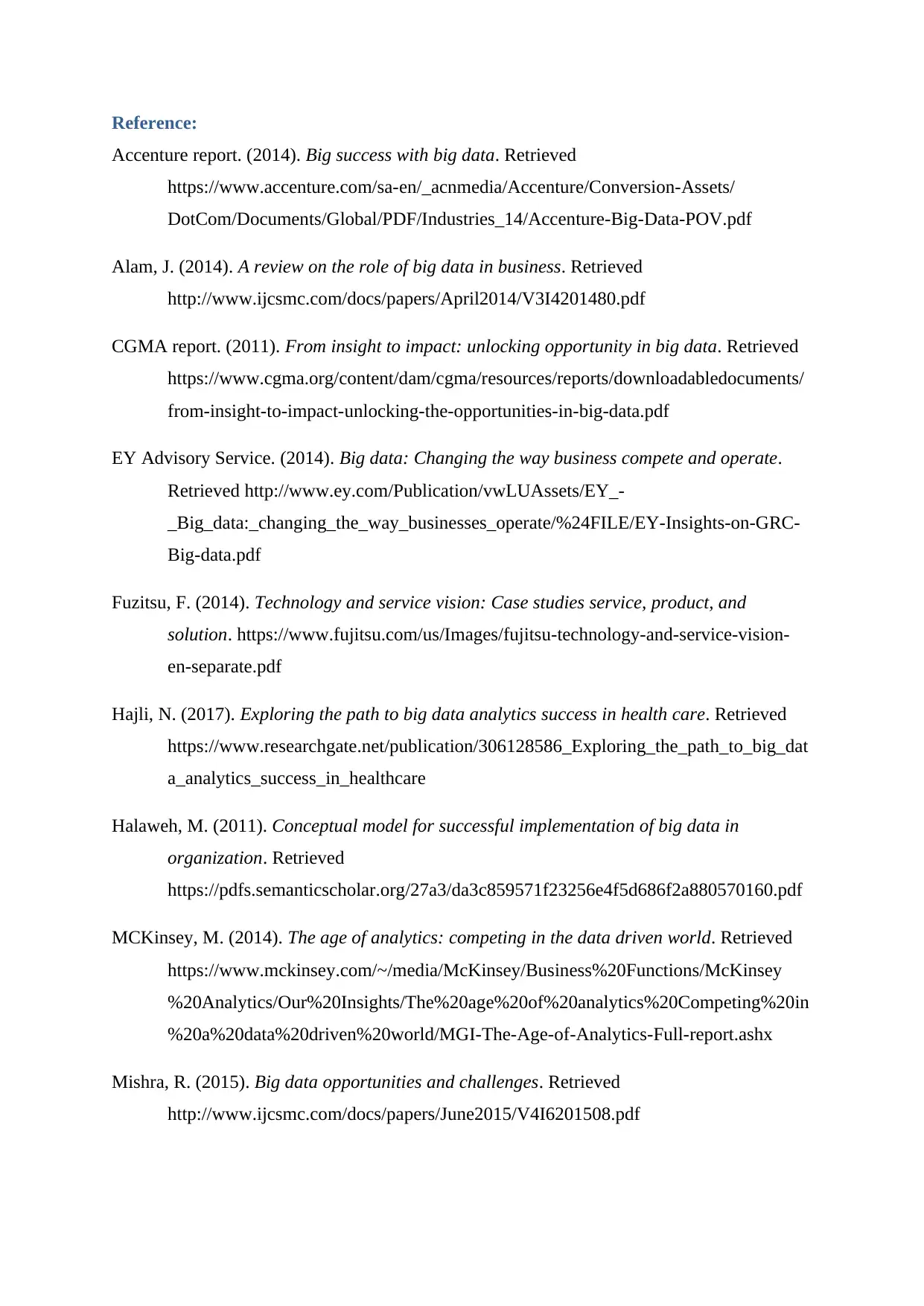
Reference:
Accenture report. (2014). Big success with big data. Retrieved
https://www.accenture.com/sa-en/_acnmedia/Accenture/Conversion-Assets/
DotCom/Documents/Global/PDF/Industries_14/Accenture-Big-Data-POV.pdf
Alam, J. (2014). A review on the role of big data in business. Retrieved
http://www.ijcsmc.com/docs/papers/April2014/V3I4201480.pdf
CGMA report. (2011). From insight to impact: unlocking opportunity in big data. Retrieved
https://www.cgma.org/content/dam/cgma/resources/reports/downloadabledocuments/
from-insight-to-impact-unlocking-the-opportunities-in-big-data.pdf
EY Advisory Service. (2014). Big data: Changing the way business compete and operate.
Retrieved http://www.ey.com/Publication/vwLUAssets/EY_-
_Big_data:_changing_the_way_businesses_operate/%24FILE/EY-Insights-on-GRC-
Big-data.pdf
Fuzitsu, F. (2014). Technology and service vision: Case studies service, product, and
solution. https://www.fujitsu.com/us/Images/fujitsu-technology-and-service-vision-
en-separate.pdf
Hajli, N. (2017). Exploring the path to big data analytics success in health care. Retrieved
https://www.researchgate.net/publication/306128586_Exploring_the_path_to_big_dat
a_analytics_success_in_healthcare
Halaweh, M. (2011). Conceptual model for successful implementation of big data in
organization. Retrieved
https://pdfs.semanticscholar.org/27a3/da3c859571f23256e4f5d686f2a880570160.pdf
MCKinsey, M. (2014). The age of analytics: competing in the data driven world. Retrieved
https://www.mckinsey.com/~/media/McKinsey/Business%20Functions/McKinsey
%20Analytics/Our%20Insights/The%20age%20of%20analytics%20Competing%20in
%20a%20data%20driven%20world/MGI-The-Age-of-Analytics-Full-report.ashx
Mishra, R. (2015). Big data opportunities and challenges. Retrieved
http://www.ijcsmc.com/docs/papers/June2015/V4I6201508.pdf
Accenture report. (2014). Big success with big data. Retrieved
https://www.accenture.com/sa-en/_acnmedia/Accenture/Conversion-Assets/
DotCom/Documents/Global/PDF/Industries_14/Accenture-Big-Data-POV.pdf
Alam, J. (2014). A review on the role of big data in business. Retrieved
http://www.ijcsmc.com/docs/papers/April2014/V3I4201480.pdf
CGMA report. (2011). From insight to impact: unlocking opportunity in big data. Retrieved
https://www.cgma.org/content/dam/cgma/resources/reports/downloadabledocuments/
from-insight-to-impact-unlocking-the-opportunities-in-big-data.pdf
EY Advisory Service. (2014). Big data: Changing the way business compete and operate.
Retrieved http://www.ey.com/Publication/vwLUAssets/EY_-
_Big_data:_changing_the_way_businesses_operate/%24FILE/EY-Insights-on-GRC-
Big-data.pdf
Fuzitsu, F. (2014). Technology and service vision: Case studies service, product, and
solution. https://www.fujitsu.com/us/Images/fujitsu-technology-and-service-vision-
en-separate.pdf
Hajli, N. (2017). Exploring the path to big data analytics success in health care. Retrieved
https://www.researchgate.net/publication/306128586_Exploring_the_path_to_big_dat
a_analytics_success_in_healthcare
Halaweh, M. (2011). Conceptual model for successful implementation of big data in
organization. Retrieved
https://pdfs.semanticscholar.org/27a3/da3c859571f23256e4f5d686f2a880570160.pdf
MCKinsey, M. (2014). The age of analytics: competing in the data driven world. Retrieved
https://www.mckinsey.com/~/media/McKinsey/Business%20Functions/McKinsey
%20Analytics/Our%20Insights/The%20age%20of%20analytics%20Competing%20in
%20a%20data%20driven%20world/MGI-The-Age-of-Analytics-Full-report.ashx
Mishra, R. (2015). Big data opportunities and challenges. Retrieved
http://www.ijcsmc.com/docs/papers/June2015/V4I6201508.pdf
⊘ This is a preview!⊘
Do you want full access?
Subscribe today to unlock all pages.

Trusted by 1+ million students worldwide
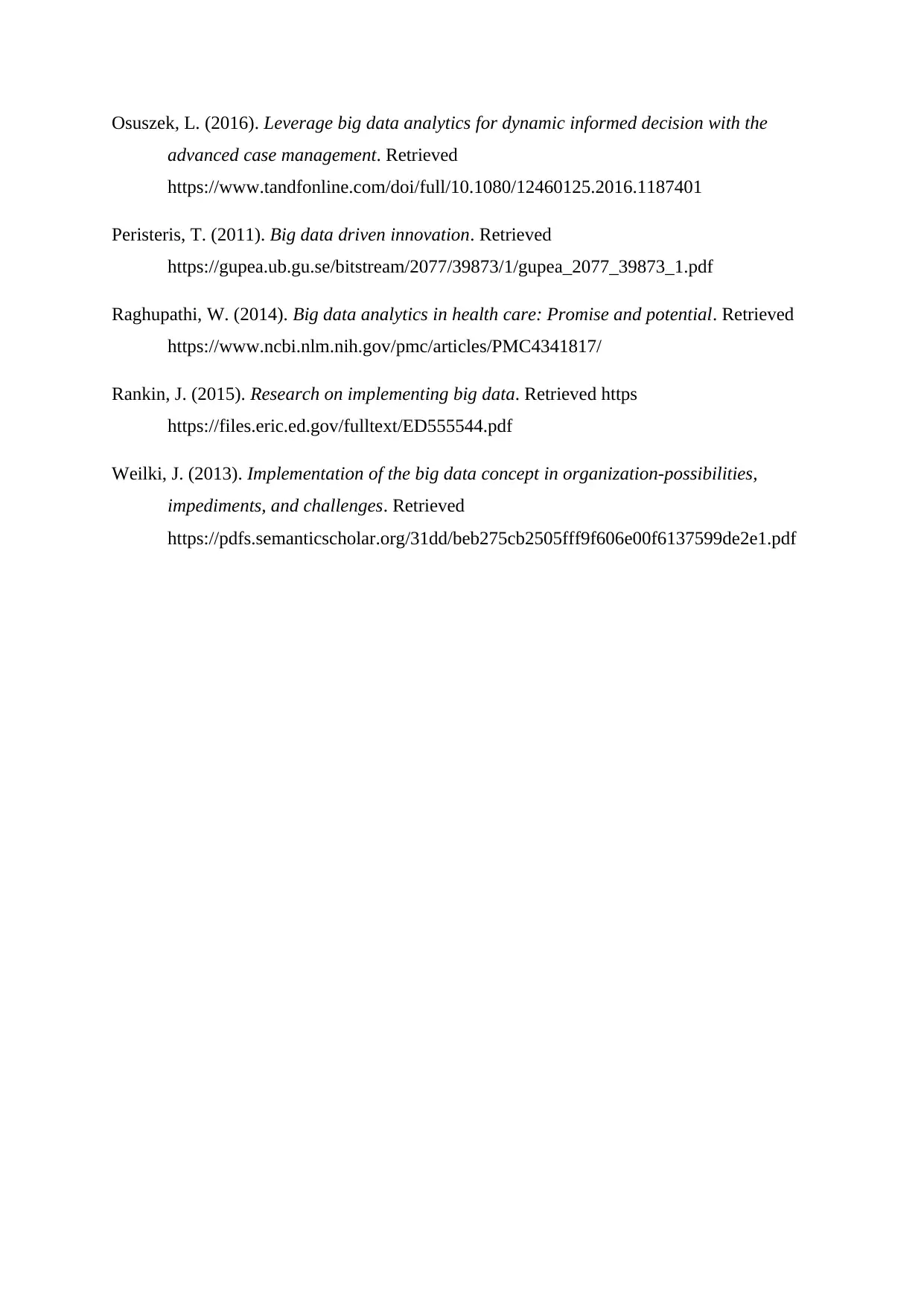
Osuszek, L. (2016). Leverage big data analytics for dynamic informed decision with the
advanced case management. Retrieved
https://www.tandfonline.com/doi/full/10.1080/12460125.2016.1187401
Peristeris, T. (2011). Big data driven innovation. Retrieved
https://gupea.ub.gu.se/bitstream/2077/39873/1/gupea_2077_39873_1.pdf
Raghupathi, W. (2014). Big data analytics in health care: Promise and potential. Retrieved
https://www.ncbi.nlm.nih.gov/pmc/articles/PMC4341817/
Rankin, J. (2015). Research on implementing big data. Retrieved https
https://files.eric.ed.gov/fulltext/ED555544.pdf
Weilki, J. (2013). Implementation of the big data concept in organization-possibilities,
impediments, and challenges. Retrieved
https://pdfs.semanticscholar.org/31dd/beb275cb2505fff9f606e00f6137599de2e1.pdf
advanced case management. Retrieved
https://www.tandfonline.com/doi/full/10.1080/12460125.2016.1187401
Peristeris, T. (2011). Big data driven innovation. Retrieved
https://gupea.ub.gu.se/bitstream/2077/39873/1/gupea_2077_39873_1.pdf
Raghupathi, W. (2014). Big data analytics in health care: Promise and potential. Retrieved
https://www.ncbi.nlm.nih.gov/pmc/articles/PMC4341817/
Rankin, J. (2015). Research on implementing big data. Retrieved https
https://files.eric.ed.gov/fulltext/ED555544.pdf
Weilki, J. (2013). Implementation of the big data concept in organization-possibilities,
impediments, and challenges. Retrieved
https://pdfs.semanticscholar.org/31dd/beb275cb2505fff9f606e00f6137599de2e1.pdf
1 out of 10
Related Documents
Your All-in-One AI-Powered Toolkit for Academic Success.
+13062052269
info@desklib.com
Available 24*7 on WhatsApp / Email
![[object Object]](/_next/static/media/star-bottom.7253800d.svg)
Unlock your academic potential
Copyright © 2020–2025 A2Z Services. All Rights Reserved. Developed and managed by ZUCOL.





